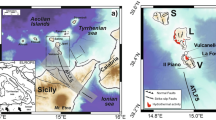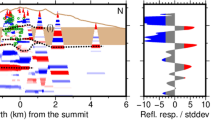Summary
We review recently obtained results about the velocity structure of the Somma-Vesuvius (Southern Italy) volcanic complex and present an interpretation of structural features, both at local and regional scale, and of the local seismicity. The local structure of Somma-Vesuvius is reviewed, referring to three depth ranges; i.e. shallow (0–5 km), intermediate (5–15 km) and deep (from 15 km to the upper mantle). The shallow velocity structure is inferred by the joint inversion of shot and local earthquake arrival time data. The main feature pointed out by this inversion is a high-velocity anomaly at the crater axis extending down to a depth of about 5 km. This anomaly can be explained with the presence of residual magma crystallised in the shallow conduits, which accumulated during the last eruptive cycles. The local seismicity is strongly clustered around this anomaly, due to the focusing effect of the rigidity contrast. The space-time seismicity pattern at Somma-Vesuvius is the result of the superposition of background seismicity, mainly due to gravitational instability of the volcanic edifice and to small external stress perturbations, with intense episodic earthquake swarms possibly due to magmatic or hydrothermal activity into the shallow system. The velocity structure in the 10–15 km depth range is characterized by the presence of a low-velocity layer, which has been independently confirmed by multi-channel seismic reflection data and P-Sv conversions from teleseismic waveforms. The study of the deep structure was performed by regional tomography with teleseisms; it confirmed the presence of a low-velocity anomaly underneath the volcano, which appears to have roots at greater depths. The regional structure between the Thyrrenian and the Adriatic sea has been inferred by tomographic inversion of teleseismic arrival times. The main result from this study which is very important for geodynamic interpretations is the first evidence for a continuous subducting slab under the Apennines, in an area where previous models hypothesized a slab window.
Similar content being viewed by others
Author information
Authors and Affiliations
Additional information
Received March 3, 2000 revised version accepted July 4, 2001
Rights and permissions
About this article
Cite this article
De Natale, G., Troise, C., Pingue, F. et al. Structure and dynamics of the Somma-Vesuvius volcanic complex. Mineralogy and Petrology 73, 5–22 (2001). https://doi.org/10.1007/s007100170007
Issue Date:
DOI: https://doi.org/10.1007/s007100170007




